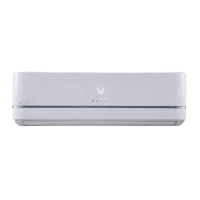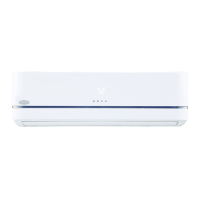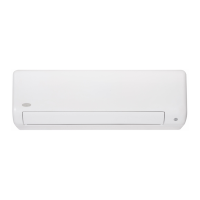Service Manual
38MGQ / 40MAQ/40MBC/40MBD/40MBF
538TR / 619PB/619RC/619RD/619RF
Multi---Zone Du ctless S plit S ystem
Sizes 18 to 48
TABLE OF CONTENTS
PAGE
SAFETY CONSIDERATIONS 1.........................
INTRODUCTION 1...................................
MODEL NUMBER NOMENCLATURE 2.................
STANDARD FEATURES AND ACCESSORIES 4...........
COMBINATION TABLE 5..............................
PHYSICAL DATA -- OUTDOOOR 6......................
DIMENSIONS -- OUTDOOR 7..........................
CLEARANCES -- OUTDOOR 11........................
ELECTRICAL DATA 12...............................
CONNECTION DIAGRAM 14..........................
WIRING DIAGRAM 24................................
REFRIGERATION CYCLE DIAGRAMS 28................
REFRIGERANT LINES 30.............................
SYSTEM EVACUATION AND CHARGING 31.............
TROUBLESHOOTING 32..............................
APPENDIX 66.......................................
SAFETY CONSIDERAT I ONS
Installing, starting up, and servicing air--conditioning equipment
can be hazardous due to system pressures, electrical components,
and equipment location (roofs, elevated structures, etc.).
Only trained, qualified installers and service mechanics should
install, start--up, and service this equipment.
Untrained personnel can perform basic maintenance functions such
as cleaning coils. All other operations should be performed by
trained service personnel.
When working on the equipment, observe precautions in the
literature and on tags, stickers, and labels attached to the
equipment.
Follow all safety codes. Wear safety glasses and work gloves. Keep
quenching cloth and fire extinguisher nearby when brazing. Use
care in handling, rigging, and setting bulky equipment.
Read this ma nual thor oughly a nd follow all wa rnings or cautions
included in literature and attached to the unit. Consult local building
codes and National Ele ct r ic a l Code ( NEC) f or s pec i al requirem ents.
Recognize safety infor m ation. This is the safet y--al ert symbol
!
!
.
Whe n you see this symbol on the unit and in instruc t ions or manua ls,
be al ert to the pote ntial for per sona l i nj ury. Unders tand the se signal
words: DANGER, WARNING, and CAUTION.
These words are used with the safety-- alert symbol. DANGER
identifies the most serious hazards which will result in severe
personal injury or death. WARNING signifies hazards which could
result in personal injury or death. CAUTION is used to identify
unsafe practices which may result in minor personal injury or
product and property damage. NOTE is used to highlight
suggestions which will result in enhanced installation, reliability, or
operation.
!
WARNING
ELECTRICAL SHOCK HAZARD
Failure to follow this warning could result in personal
injury or death.
Before installing, modifying, or servicing system, main
electrical disconnect switch must be in the OFF
position. There may be more than 1 disconnect switch.
Lock out and tag switch with a suitable warning label.
EXPLOSION HAZARD
Failure to follow this warning could
result in death, serious personal injury,
and/or property damage.
Never use air or gases containing
oxygen for leak testing or operating
refrigerant compressors. Pressurized
mixtures of air or gases containing
oxygen can lead to an explosion.
!
WARNING
CAUTION
!
EQUIPMENT DAMAGE HAZARD
Failure to follow this caution may result in equipment
damage or improper operation.
Do not bury more than 36 in. (914 mm) of refrigerant pipe
in the ground. If any section of pipe is buried, there must be
a 6 in. (152 mm) vertical rise to the valve connections on
the outdoor units. If more than the recommended length is
buried, refrigerant may migrate to the cooler buried section
during extended periods of system shutdown. This causes
refrigerant slugging and could possibly damage the
compressor at start--up.
INTRODUCTION
This Ser vi ce Manua l provides the nece ssar y inf orma tion to se rvi c e,
repair, and maintain the multi--zone family of heat pumps. Section 2
of thi s manua l has an appendi x wit h dat a required to perform
troubles hoot ing. Use the Table of Contents to locate a desire d topi c.













